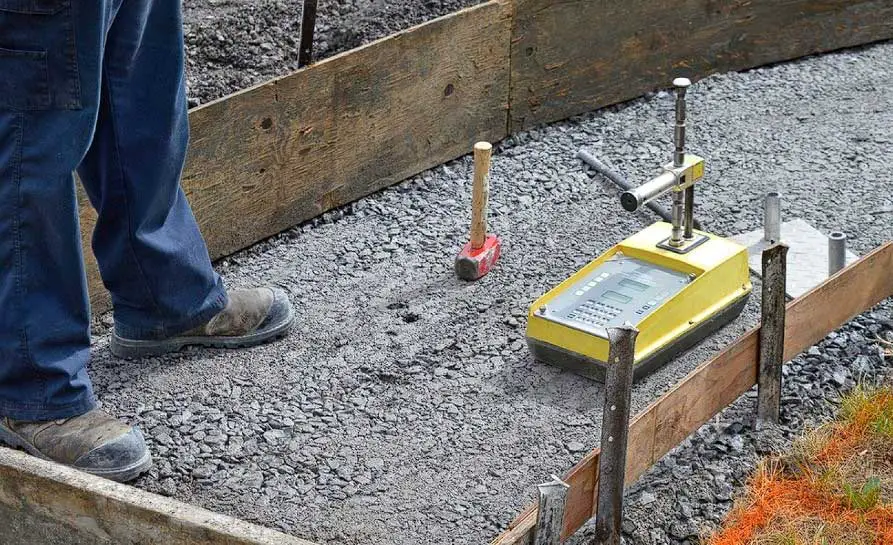Table of Contents
What is the Method Statement for Testing of In-place Density / Field Density By Nuclear Method?
This method statement presents the methodology to be implemented for the execution of testing for In-Place Density / Field Density by Nuclear Method.
The purpose is to establish a procedure for testing, monitoring, and reporting for field density of compacted soil and soil-aggregate substrates. The density of the material may measure by direct transmission, backscatter, and backscatter/air-gap ratio methods.
Measurement for water (moisture) content is taken at the surface in backscatter mode. The total (wet) density of soil aggregate is measured by the attenuation of gamma radiation where indirect transmission, the source is placed at a known depth up to (300) mm, and the detector remains on the surface or in backscatter and backscatter/air-gap the source and detectors both remain on the surface. The density of the test sample in mass per unit volume is calculated by comparing the detected rate of gamma radiation with previously established calibration data.
Work Execution
Testing method statements for In-Place Density by Nuclear Method follows ASTM D 6938-17a providing 2 procedures as follows:
- Direct Transmission Method – in which the probe extends through the base of the gauge into the pre-formed hole to a described depth, this is the preferred and common method in construction projects.
Most field compaction tests / in-place density tests are now performed using nuclear density gauges that employ a cesium element.
Nuclear gauges can have significant errors if the extendable probe is located next to a stone or rock > 3 inches across. In rocky fills the technician should always rotate the probe 90 degrees and take a second reading then record the lower of the two values. - Backscatter method – in which the gauge or the probe in the backscatter position, this is places the gamma and neutron sources and the detectors in the same plane.
Test Methodology
Apparatus:
Nuclear Gauge (most common is the Troxler model): Calibrated Gauge, consists of the following:
Gamma source- A sealed source of high-energy gamma radiation such as cesium or radium.
Gamma detector
Fast neutron source-A sealed mixture of radioactive material such as americium and target material such as beryllium.
Slow neutron detector
Reference standard -A block of material used for checking instrument operation, correction of source decay, and establishing conditions for reproducible reference count rate.
Site preparation device -A plate leveling tool used for planning the test site to the required smoothness, and in the direct transmission method guiding the drive pin to prepare a perpendicular hole.
Driver pin- A pin of a slightly large diameter than the probe in the direct transmission instrument used to prepare a hole in the test site for inserting the probe.
Driver pin guide- A fixture that keeps the driver pin perpendicular to the test site.
Slide Hammer- Heavy enough to drive the pin to the required depth without undue distortion.
Driver pin extractor- A tool used to remove the driver pin in a vertical direction so that the pin will not distort the hole in the extraction process.

Standardization
Nuclear moisture density gauges are subject to long-term aging of the radioactive sources, which may change the relationship between count rates and the material density and water content. To correct this aging effect, gauges are calibrated as a ratio of the measurement count rate to a count rate made on a reference standard.
Standardization of the gauge shall be performed at the start of each day’s use, and record these data. Perform the standardization with the gauge located at least 9 m away from other nuclear moisture density gauges and clear of large masses of water or other items which can affect the reference count rate.
The Poisson distribution of nuclear decay events, the half-life of the isotope used for the measurements, and other electronic and mechanical sources of variance all contribute to the variability and change in gauge standardization counts over time.
The purpose of the daily standardization count is twofold -to compensate for the temporal effects on the gauge count rate and to aid in identifying unacceptable levels of change in gauge response.
Wet density and water mass per unit volume properties of the soil under test are determined by first dividing the measurement count by the standardization count, the resulting ratio is then used as the dependent variable in the calibration equation to determine the wet density and water mass per unit volume of the soil.
Daily standardization counts are initially evaluated as follows:
- The density and water standardization count taken on a given day are compared to the respective average of the four preceding standardization counts.
- If the density standardization count falls within ±1% of the average density counts, then the density standardization count is acceptable.
- If the water standardization counts fall within ±2%of the average water counts, then the water standardization count is acceptable.
- If either standardization count fails to meet these limits, it is typically because of an excessive amount of time that has passed between consecutive standardization count and natural source decay preventing meeting this criterion, then evaluation of standardization counts as per standard requirements.
See Also: Method Statement for Civil Engineering
Procedure
Select the test location where the place will be placed at least 600 mm away from any object sitting on or projecting above the surface of the test location. For special locations such as trenches follow the gauge manufacture correction procedure.
Remove all loose and disturbed material and additional material as necessary to expose the true surface of the material to be tested.
Prepare an area sufficient in size to accommodate the gauge by grading or scraping the area to a smooth condition so as to obtain maximum contact between the gauge and the material being tested.
Fill the voids and smooth the surface beneath the gauge by using native material or fine sand for approximately a depth of 3 mm.
The placement of the gauge on the surface of the material to be tested is critical to accurate density measurements. The optimum condition is total contact between the bottom surface of the gauge and the surface of the material being tested. The total area filled should not exceed approximately 10 percent of the bottom area of the gauge.
Turn on and allow the gauge to stabilize according to manufacturer recommendations.
A. The Direct Transmission Method:
Select a test location where the gauge in the test position will be at least 150 mm away from any vertical projection.
Make a hole perpendicular to the prepared surface using the rod guide and drive pin, the hole should be a minimum of 50 mm deeper than the desired measurement depth and of an alignment that the insertion of the probe will not cause the gauge to tilt from the plane of the prepared area.
Mark the test area to allow the placement of the gauge over the test site and to align the source rod to the hole.
Remove the hole-forming device carefully to prevent the distortion of the hole, damage to the surface, or loss of material to fall into the hole.
Place the gauge on the material to be tested, and lower the probe to the desired test depth.
Pull the gauge gently toward the back, or detector end, so that the back side of the probe is in intimate contact with the side of the hole in the gamma measurement path.
The probe containing radioactive sources is not to be extended out of its shielded position prior to placing it into the test site.
Keep all other radioactive sources at least (9 m) away from the gauge to avoid any effect on the measurement.
If the gauge is so equipped, set the depth selector to the same depth as the probe.
Secure and record one or more one-minute density and water content readings.
Read the in-place wet density and water content directly.
B. The Backscatter Method:
Seat the gauge firmly.
Keep all other radioactive sources at least 9 m away from the gauge to avoid affecting the measurement.
Set the gauge into the backscatter (BS) position.
Secure and record one or more set(s) of one-minute density and water content readings.
Read in-place wet density or determine one by use of calibration curve or previously. Read the water content.
When oversize particles are present, the gauge can be rotated about the axis of the probe to obtain additional readings as a check, where is any uncertainty as to the presence of these particles it is advisable to sample the material beneath the gauge to verify the presence and the relative proportion of the oversize particles.
When sampling for water content correction or oversize particle correction, the sample should be taken from the zone directly under the gauge. The size of the zone is approximately 200 mm in diameter and a depth equal to the depth setting of the probe when using the direct transmission mode or approximately 75 mm in depth when using the backscatter mode.
Method Statement for Testing of In-place Density By Nuclear Method – Calculation:
Determine the wet density:
Read the value directly in kg/m3, if the density reading is in counts determine the in-place wet density by use of this reading and previously established calibration curve, and record the density to the nearest 1 kg/m3
Determine the water content:
Use the gauge reading for (w) if the gauge converts to that value or determines water mass per unit volume in kg/m3, calculate (w) using the formula:
w = (Mm x 100) / pd or w = (Mm x 100)/(p-Mm)
Where:
w = water content
pct: dry density in (kg/m3)
p: wet density in (kg/m3)
Mm: water mass per unit volume in (kg/m3)
Record water content to the nearest 0.1 %.
Determine the dry density:
If the water content obtained by the nuclear method use the gauge reading directly for dry density in (kg/m3), and also from the calculation
Pd = p-Mm
If the water content is determined from a sample calculate dry density from the:
Pd = (100xp)/(100+W)
Record the dry density to the nearest 1 kg/m3.
Determine the percent compaction.
By dividing the in-place dry density by the laboratory maximum dry density and multiplying by 100.
References:
ASTM D 6938-17a – Standard Test Methods for In-Place Density and Water Content of Soil and Soil-Aggregate by Nuclear Methods (Shallow Depth)
Quality Procedure for Method Statement for Testing of In-place Density by Nuclear Method
The Inspection and Test Plan (ITP) for this Method Statement summarizes various characteristics to be checked. The concerned Site Engineer or Site Supervisor will be responsible to ensure compliance for these operations and the site QA / QC Engineer will carry out quality control checks and report the inspection results.
tag: # Method Statement for Testing of In-place Density By Nuclear Method
Written by:
As someone with over two and a half decades of experience in the construction industry, I possess the expertise and background to comprehend your customers’ wants and needs.
Throughout my career, I’ve been involved with general contractors and subcontractors, fulfilling various roles within the commercial and residential construction sectors. My area of expertise lies in project administration, contracts, and accounting.
